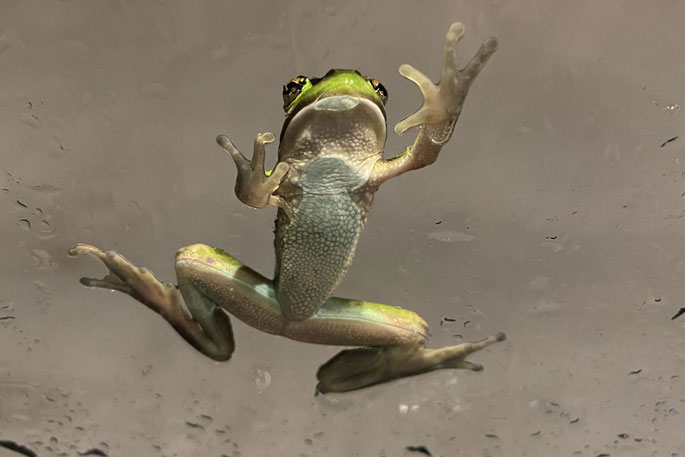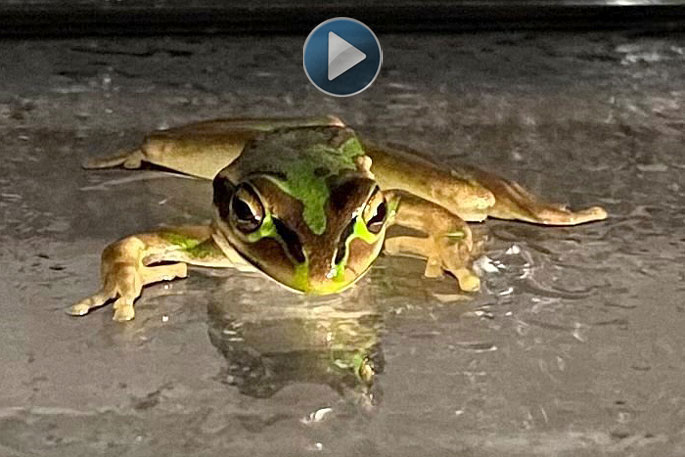Over the last few week, Papamoa residents have been receiving late night visitors and hearing what sounds like dirt bikes roaring around a small track at night. Others thought it could be power tools.
On investigating, the culprits were found to be tiny, green and hopping. And clinging to windows and ranch slider doors.
It's that time of the year again, when Papamoa and Te Puke residents rediscover the joy of frogs means they live in a healthy environment.
Young frogs have been hopping from the Papamoa waterways making their way to local gardens in search of an insect smorgasbord.
Frogs are natural insect killers, eating up mosquito larvae, flies, mosquitoes, cockroaches, wasps, ants, worms and cabbage white butterflies.
Night-time insects are attracted to outside and internal house lights, which in turn attract the frogs to feast on the insects.
The Papamoa frogs are the Green and Golden Bell Frog, formerly known as Litoria aurea and recently changed to Ranoidea aurea.
They were originally introduced from Australia around 1875 by the acclimatisation societies.
Frogs are disappearing around the world, and the Green and Golden Bell frog in Australia is classified as 'Vulnerable” by the IUCN and is a threatened species.
They are not an endangered species in New Zealand.
A single female frog can lay between 3000-10,000 eggs, most of which will die as they are eaten by dragonfly and damselfly larvae, kingfishers, herons and shags.
The young frogs appearing now were probably laid as eggs around two to three months ago.
Frogs are important indicators of a healthy environment. If they start to decline in numbers then it means something is wrong with the environment which if left unabated may have direct consequences on human health. So, having frogs in a neighbourhood is a really positive sign.
 Papamoa resident Melanie Wilton discovered frogs climbing her ranchslider. Photo: Melanie Wilton.
Papamoa resident Melanie Wilton discovered frogs climbing her ranchslider. Photo: Melanie Wilton.
If frogs come inside a house then they can be simply released into the garden. They will happily live for a couple of years away from the water in a garden conducting their natural service of pest control. Then they will migrate one early summer to a water body and breed.
Tadpoles are good too for the waterways as they eat bacteria, algae and detritus – so they keep the waterways clean.
Herbicides are detrimental for frogs and if they don't kill them immediately, then they can chemically castrate them, so males start to grow eggs on their testes, stop calling and can no longer breed.
As well as chemicals killing frogs, introduced fish like goldfish and mosquito fish are bad for frogs. Introduced mammals such as hedgehogs like frogs too. Domestic cats which like to ‘play' with a frog until it's no fun anymore, may end up killing the frog. A cat doesn't tend to eat a frog as it has an unpleasant taste for the cat.
Bell frogs love hot, wet conditions, and breed in pools and ponds around Papamoa. One female frog could lay thousands of eggs, and once the tadpoles turn into frogs they often have to get away from water to avoid being eaten by herons and other predators.
Once indoors the frogs can get scared - and make a high-pitched scream.
This may be because they are probably getting stressed. Inside a house is not a good place for a frog to be because it's very dry.
They have a permeable skin where they would start to lose water, so even the act of going across a dry carpet could be enough of an irritant on their skin, and when they are losing water, they get stressed.
Their screaming can thus be because they think they are being attacked by a big, furry, dry predator.
For those who don't want frogs, they should probably not use outside lights, make sure the windows and the doors are shut and put a draught excluder under the door to stop them coming in.
There has probably been an increase in the number frogs in Papamoa over the last couple of years because of the hot, wet weather and because there have been plenty of garden ponds and pools in the area.
Papamoa's ‘plague' should only last a week or so, until all the young frogs have moved on to a more desirable habitat.
So, should you find a frog climbing your ranch slider please release it gently into your garden.



3 comments
Good article.
Posted on 19-02-2021 12:47 | By morepork
Well-written and informative. Thanks, Sun Live.
Well if you have FROGS
Posted on 19-02-2021 21:24 | By The Caveman
In your "wetlands" at least you know that the WATER in your wetland is not TOXIC !!! The first thing to disappear from toxic wetlands are FROGS !!
Tom Ranger
Posted on 24-02-2021 10:38 | By Tom Ranger
Humans invading the frogs territory. Not the other way around. I can tell ya which will come off second best.
Leave a Comment
You must be logged in to make a comment.